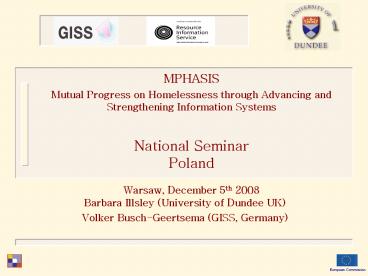MapInfo - an introduction - PowerPoint PPT Presentation
1 / 15
Title:
MapInfo - an introduction
Description:
Title: MapInfo - an introduction Author: mwgpollard Last modified by: Volker Busch-Geertsema Created Date: 2/7/2001 10:37:34 AM Document presentation format – PowerPoint PPT presentation
Number of Views:122
Avg rating:3.0/5.0
Title: MapInfo - an introduction
1
MPHASIS Mutual Progress on Homelessness through
Advancing and Strengthening Information
Systems National Seminar Poland Warsaw,
December 5th 2008
2
Purpose of Mphasis
- Measuring Homelessness Report
- ec.europa.eu/employment_social/social_inclusion/do
cs/2007 - Improve Capacity
- National Authorities in data collection on
homelessness - MPHASIS Approach
- Mutual Learning / Practice Strand
- Research Strand
3
Seminar Purpose
- PROGRESS - Social Inclusion Strategy
- Mutual Learning
- Mobilising all actors
- Commission Expectations
- Concrete Outputs and Outcomes
- National Seminars
- Agreed outcome statement on actions required to
improve data collection on homelessness
4
Purpose of Data Collection
Strategy Aims to Data needed for
Prevent homelessness People vulnerable to eviction People who leave an institution with no home
Tackle the causes of homelessness Data reflecting different pathways
Reduce the level of homelessness Scale and prevalence of homelessness
Reduce the negative effects on homeless people Longitudinal analysis / repeat homelessness
Ensure that formerly homeless people can sustain permanent independent housing Number who gain access to permanent or supported accommodation and remain there
5
Homeless Pathways and Data Sources
6
Data Collection Overview
Homeless Homeless persons surveys France, Spain, Italy
Homeless Service Providers / Client Registers Netherlands, Ireland
Social Welfare / Support Official Registers of Services Czech, Hungary, Latvia
Social Welfare / Support Regulation Denmark
Social Welfare / Support Funding UK
Housing Allocation UK
Housing Needs Assessment Finland, Ireland, Scotland
7
Graph SlideTypology of Living Situations
8
Operational Definition
Operational Category Operational Category Living Situation Living Situation
1 People Living Rough 1 Public space / external space
2 People in emergency accommodation 2 Overnight Shelters
3 People living in accommodation for the homeless 3 4 5 6 Homeless Hostels Temporary Accommodation Transitional Supported Accommodation Womens shelter or refuge accommodation
4 People living in institutions 7 8 Health care institutions Penal institutions
5 People living in non-conventional dwellings due to lack of housing 9 10 11 Mobile homes Non-conventional building Temporary structure
6 People living temporarily with family and friends 12 Conventional housing, but not the persons usual place of residence
9
Homelessness Information Strategy
- Driven by Strategy
- Definition of homelessness and housing exclusion
- Review of information sources
- Service Provider Database
- Core Variables Definition
- Client Register information
- Administrative Data / Survey Data
10
Homelessness System Indicators
- Input Indicators
- Threatened with eviction
- Leaving institutions
- Children leaving care
- System Indicators
- Number of people receiving services
- Time spent in the system
- Flow of people through the system
- Output Indicators
- People re-housed (with/without support)
11
Homelessness Accommodation System
12
Supply and User Statistics
- Directory of Services
- Bed-spaces
- Prevalence occupancy rate
- Client Registers
- Occupancy level
- Turnover
- Duration
- Profile and Trends
- Profile demography
- Pathways profile
- Administrative geographies
13
Core Variables
- Test usability of Core Variables in all MPHASIS
countries - Demographic characteristic (age and gender),
- Nationality and migration background (country of
birth), - Composition of homeless households,
- Accommodation situation (immediately before
service period and at time of data collection), - Duration of (current) homelessness,
- Reasons for (last) homelessness.
- Common understanding? Data available?
Harmonisation possible? Amendments necessary? - Obstacles for implementation of missing variables
and possible solutions
14
Outcome Statement
- Homelessness Strategy
- Is there any such strategy?
- What are the data needs of strategy / policies?
- Are there any plans for regular monitoring?
- How can an operational definition of homelessness
be developed and used? - Existing Systems
- National/regional databases of services set up?
- Client register systems installed and used for
providing more continuous information? - What gaps exist / Reliability of data?
- Is definition of core variables agreed by actors?
15
Outcome Statement
- Barriers
- How can data protection issues be addressed?
- Is funding adequate / sustainable?
- How can barriers be overcome?
- Information Strategy
- Is responsibility / governance clear?
- Is there a mechanism for review?
- What is the action plan for implementation?
- National Action
- Agreement of outcome statement and action to
progress data collection - Sharing progress and information from national
meetings and MPHASIS website www.trp.dundee.ac.uk/
research/mphasis/ - Report back to final MPHASIS conference in
September 2009































